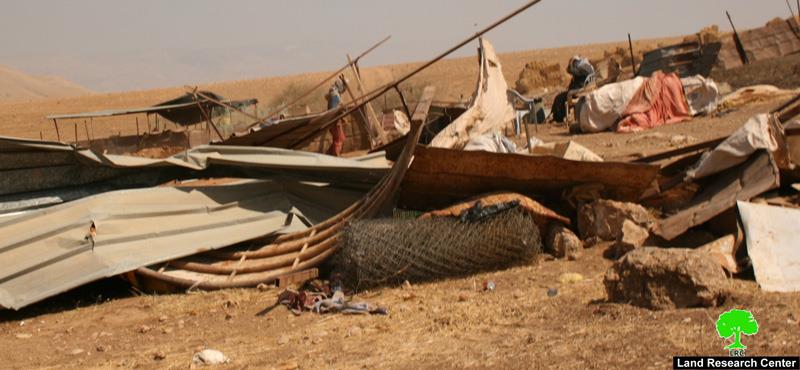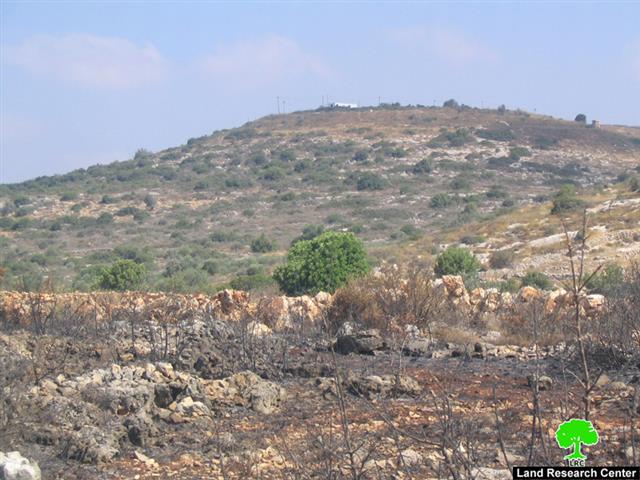Demolitions, Land Confiscations and Population Evictions: –
Israeli occupation forces have carried out a series of demolitions and destructions in a number of areas in the northern Jordan Valley at the end of July, 2007. For example, a water cistern with a capacity of 200 m3, owned by Mr. Moa�ayyad Abdel Ra�oof Sawafta, 74 years old, from the village Bardala in the northern parts of Tubas Governorate, was demolished. Israeli occupation forces had issued a demolition order against it in April 2006 under the pretext that it was built without the proper permit especially that it was constructed in Area C.
Similarly, Israeli occupation forces have demolished a water cistern in the village of Farush Beit Dajan located south east of the Governorate of Tubas and was owned by Mr. Adnan Nofel Al Zubeidat, 59 years old. It had a capacity of 140 m3 as it was demolished for �lack of permit.�
Ethnic Cleansing: –
In accordance with the ethnic cleansing policy adopted by Israeli occupation forces in the Jordan Valley since the 1990�s, these forces demolished on the 22nd of August, 2007 a large number of Bedouin tents in the Khirbets of Humsa, Al Hadidiya and Al Aqaba, all located east of the Governorate of Tubas. It, also, demolished the houses and animal pens of Mr. Abdullah Hussein Bisharat, 31 years old, and Mr. Abdullah Hafez Bisharat, 22 years old, without giving the owners time to remove their belongings.

(Photo 1 & 2: Al Aqaba- Tubans: Ruins of human dwellings and animal pens
destroyed by the Israeli army this summer)
Moreover, these forces have confiscated a water tank used for water storage in addition to an agricultural tractor belonging to Mr. Hussein Bisharat from Khirbet Khirbet Al Haddidiya. Such actions were taken by the invading forces in attempt to force the eviction of the residents of the Khirbet as the owner was told that these forces wouldn't return the confiscated items back to him unless he leaves Al Haddidiya.
Likewise, the Israeli occupation authorities have been withholding since May 2007 in Ashdod port a water tank of 12m3 capacity donated by the Japanese Development Agency to be used to supply water to Khirbet Al Aqaba. Ever since, the authorities are refusing to release the tank as to pressure the residents of the Khirbet to leave the place which does not have any local sources of water. It is worth noting that the port authorities are charging a daily fee for the storage of the water tanker while it demands the village council to pay the fees despite the fact that the council did not receive the tanker as of yet.
Mr. Sami Sadeq, the 59-years-old head of the Al Aqaba village council, indicated in an interview with LRC that the withholding of the water tanker is part of the policy of collective punishment practiced by the Israeli occupation forces for a long time. He pointed out that in 1998 the village council filed a law suit against the IDF concerning its practices in Tasifa Camp located at the main entrance of the village. The Israeli High Court decided in 2002 that the camp must be dismantled and moved to some other place. The dismantling took place on November 12th, 2003. In retaliation, Israeli occupation forces gave demolition orders against 13 houses and establishments in the village under the pretext of being built without a permit !!!. Additional orders were issued later. Currently, there are 28 demolition orders issued, of which one was designated to the mosque of the village.
(Photo 3: Al Aqaba- Tubans: Some of the threatened houses and animal pens in the village )
In addition to what was stated earlier, Israeli occupation forces had made it a habit of spreading fear and terror in the hearts of the residents of the village through conducting a series of military maneuvers between the houses which included hiding behind trees and opening random fire while chasing shepherds and raiding the village during the late hours of the night while using illumination and sound bombs.
A Continuous Series of Displacement and Population Replacement: –
The demolitions that took place in the northern parts of the Jordan Valley are part of a general policy executed by occupation forces in the Jordan Valley in general and in Al Buquei�a valley specifically. The goal of the policy is to evict the Palestinians from the region in order to replace them by Israeli settlers. The policy manifested itself in targeting the Bedouin communities in the region and demolishing their tents and shacks four times in a row. Yet, despite that the Palestinian residents usually rebuild their �homes� again in defiance of the eviction policy and in a deep insistence in staying in homes and lands they lived in and owned for hundreds of years.
In 1995 Israeli occupation forces raided Al Riwaq location in Buquei�a valley and initiated a far-reaching demolition campaign of tents and animal pens. They, also, confiscated tools and metal sheets as to force the Palestinian residents to leave without any possible return. Yet, despite that, the Palestinian residents re-established their community in another location called Arraq Al Isba�a a few kilometers away from the location of which they were evicted.
( Map 1: Northern Ghor: Locations of the threatened villages and the growing Israeli settlements in the area)
In 1997 Israeli occupation forces did it again as they destroyed shelters and animal pens in Al Haddidiya. Palestinians rebuilt their community there again. Occupation forces came back and demolished the community three additional times. Yet, each time the Palestinians would come back despite the Israeli policy and practices. After the latest demolishing, Mr. Abdullah Hussien Barakat indicated that: �even if we are to live under the stones, we won�t leave our land. Every time they would destroy our community, we will be back to rebuild it.�
In addition to house demolition, Israeli occupation forces raid the tents of the Palestinians on daily basis while chasing the shepherds and confiscating their flocks, opening fire at them, arresting and physically beating them. Moreover, it imposes huge fines on the shepherds using shallow arguments as well as reducing their grazing area to the minimum while preventing them from reaching their water cisterns to use its water for them and their animals.
What the Israeli occupation forces are doing in Al Haddidiya is considered to be a step in the ethnic cleansing policy implemented by the State of Israel against all of the Palestinian Bedouin communities spread throughout the West Bank. It is no secret that Israeli occupation authorities are planning to throw these communities out of their current residence place and to displace them to the nearest towns as to control their lands which spread through the eastern slopes of the West Bank. These lands will, undoubtedly, be turned over to the settlers to be used for further settlement expansion.
Occupationâ��s Water Policy in the Jordan Valley: –
-
Ever since the occupation of the West Bankin 1967 Israeli occupation forces kept the right of digging for underground water as well as building cisterns in the Jordan Valley and east of the Governorate of Tubas for the Israeli Water Company (Makharot). The Company began digging wells at medium depths (less than 300 meters) which ultimately led to the drying up of Palestinian springs and the increase in its salinity. This, in turn, gave way to a reduced share of water to the Palestinian population which forced them to depend on buying it from the Israeli Company at greater cost.
-
Israeli occupation forces have transformed the area surrounding the Jordan River to a Closed Military Area with a width between 1 and 5 kilometers which led to the destruction of agricultural lands in the area. Israel has denied the Palestinians their share of the water (estimated to be 250 million m3 yearly) while it transformed that water to the Israeli settlements in the valley and in Tubas.
-
Makharot dug up wells atop the aquifer in the villages of Bardala and Ein Al Beida north of the Governorate of Tubas. This water theft and loss has led to the destruction of agricultural yields in thousands of dunums in Bardala, Kardala, Ain Al Beida in addition to Al Buquei�a valley. The Company built two wells inside the village of Bardala (the wells were called Bardala 1 and Bradala 2) which pumps 1500 cubeshour which led to the drying up of 12 wells and 22 springs that used to supply the Palestinians with 6 million m3 of water yearly. Currently, most of the water used by the Palestinians is bought from Makharot.
-
There are currently 14 wells in Tubas Governorate that are under the danger of becoming dry in accordance to information supplied by the Palestinian Negotiation Department.
Prepared by
The Land Research Center
LRC
















